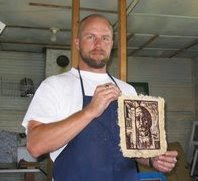
I am currently finishing up a couple of paintings on memory and how much circumstance plays a role in the recording of "facts." I am using the raven metaphorically to suggest the difference between two paintings on a visit my sister and I made to Wounded Knee in 2004.
In the painting I use text to recall the events as they unfolded that evening and how they have played a role in my appreciation for that place and the resistance of those that live on the reservation there. Many people might say that Wounded Knee has two histories, one in 1890 when the band of Lakota following Sitting Bull's brother, Big Foot, were massacred by soldiers under the command of Colonel James W. Forsyth. Another happened when members of the American Indian Movement held off federal forces for 71 days in 1973 . I say the history of that place is a continuous one that runs uninterrupted through the present day; an embarrassing one of religion, culture, government, and money. My experience there is one of a drive through desperate poverty in the middle of the American heartland overlooked and unnoticed by many.

Of particular notice for me was the graffiti on the gate to the small chapel on the hill where someone expressed their loss and remembrance of those held dear to them. A subtle but poignant note from a person searching for a voice that will carry in the winds of South Dakota.
The place stood in sharp contrast for me to the Little Bighorn memorial in Montana, which I visited earlier that summer on my way to the studio in North Dakota. Although the "the Custer Battlefield" shared the raw history and timelessness of the prairie the headstones, sidewalks, gift shops, and visitors were quite different from that faded blue-green sign that insufficiently tells the tale of Wounded Knee.
In the painting I use text to recall the events as they unfolded that evening and how they have played a role in my appreciation for that place and the resistance of those that live on the reservation there. Many people might say that Wounded Knee has two histories, one in 1890 when the band of Lakota following Sitting Bull's brother, Big Foot, were massacred by soldiers under the command of Colonel James W. Forsyth. Another happened when members of the American Indian Movement held off federal forces for 71 days in 1973 . I say the history of that place is a continuous one that runs uninterrupted through the present day; an embarrassing one of religion, culture, government, and money. My experience there is one of a drive through desperate poverty in the middle of the American heartland overlooked and unnoticed by many.

Of particular notice for me was the graffiti on the gate to the small chapel on the hill where someone expressed their loss and remembrance of those held dear to them. A subtle but poignant note from a person searching for a voice that will carry in the winds of South Dakota.
The place stood in sharp contrast for me to the Little Bighorn memorial in Montana, which I visited earlier that summer on my way to the studio in North Dakota. Although the "the Custer Battlefield" shared the raw history and timelessness of the prairie the headstones, sidewalks, gift shops, and visitors were quite different from that faded blue-green sign that insufficiently tells the tale of Wounded Knee.

No comments:
Post a Comment